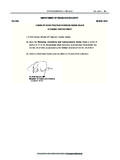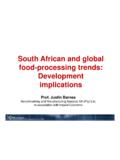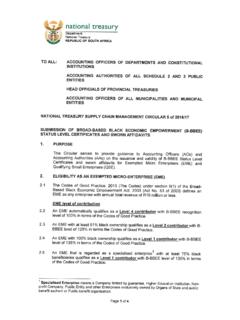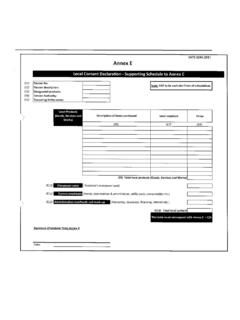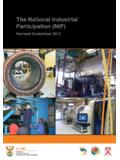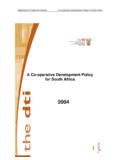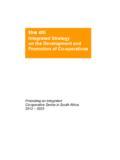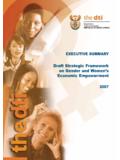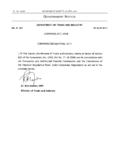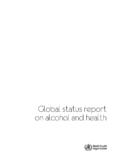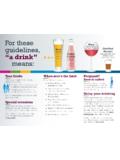Transcription of CHAPTER 2 Alcohol demand/consumption …
1 CHAPTER 2 SA Alcohol demand patterns Economic Impact of Advertising Ban on Alcoholic Beverages ARA Page | 23 CHAPTER 2 Alcohol demand / consumption patterns in South Africa3 Background One of the reasons that no one regulatory system is suited to all countries is because the pattern of Alcohol consumption varies so widely by country. Before good interventions to reduce the harms associated with Alcohol can be designed, it is first necessary to understand the pattern of those harms. This section gives an overview of the pattern of Alcohol demand and consumption patterns in South Africa. How much do people drink? Adult per capita Alcohol consumption The true picture of Alcohol consumption is often shrouded in myths and assumptions.
2 A statistical presentation and mapping of the level and patterns of global, regional and South African Alcohol consumption by adults 15 years and older provides a sound basis for the analysis of problems related to Alcohol . Data presented in this section was sourced from the World Health Organization s (WHO) Global status report on Alcohol and health, 2011 . The principal measure is adult per capita Alcohol consumption (APC) in litres of pure Alcohol (see Box 3). Box 3: Adult per capita Alcohol consumption (APC) WHO definition Total adult per capita Alcohol consumption is the adult (the population of 15 years and over) per capita amount of Alcohol consumed in litres of pure Alcohol in a given population. Total APC consists of the average APC of recorded Alcohol in 2003 2005 and the APC of unrecorded Alcohol (see Box 4) in 2005.
3 The WHO uses adult per capita data to measure Alcohol consumption , instead of the widely used per capita for the whole population . This is to balance the fact that population distributions in developing countries are quite different from developed countries (they have much larger proportion of children and young people). Using per capita consumption would mean that consumption among adults would be underestimated in those countries with many young people (if it were assumed that most young people under 15 years do not consume significant quantities of Alcohol ). South African adult per capita Alcohol consumption in 2005 equalled litres of pure Alcohol . Of this consumption , or litres per person, was homemade and illegally produced Alcohol or, in other words, unrecorded Alcohol .
4 The consumption of homemade or illegally produced Alcohol may be associated with an increased risk of harm because of unknown and potentially dangerous impurities or contaminants in these beverages. APC in South Africa (of ) is above the world average of , the regional average for Africa of , the average for the Americas of , the average for the South-East Asia region of , and the average for the Western Pacific region of It is, however, below the European regions APC of South Africa has the 75th highest APC in the world. A large variation exists in adult per capita consumption globally (see Chart 24). The highest consumption levels can be found in the developed world, mostly the Northern Hemisphere, but also in Argentina, Australia and New Zealand South Africa s APC is lower than the majority of developed countries (see Chart 25).
5 Medium consumption levels can 3 Main source for this CHAPTER : World Health Organization s (WHO) Global status report on Alcohol and health, 2011 . CHAPTER 2 SA Alcohol demand patterns Economic Impact of Advertising Ban on Alcoholic Beverages ARA Page | 24 be found in North and South America and southern Africa, with South Africa having among the highest levels (South Africa has the highest APC in Africa, with the exception of Namibia, Uganda, and Nigeria). Low consumption levels can be found in the countries of North Africa and sub-Saharan Africa, the Eastern Mediterranean region, and southern Asia and the Indian Ocean - these regions represent large populations of the Islamic faith, which have very high rates of abstention.
6 Chart 24: Global per capita Alcohol consumption pattern Chart 25: Adult per capita consumption in SA vs. selected African countries (average 2003-2005) Chart 26: Adult per capita consumption in SA vs. selected developed countries (average 2003-2005) CHAPTER 2 SA Alcohol demand patterns Economic Impact of Advertising Ban on Alcoholic Beverages ARA Page | 25 Chart 27: Adult per capita consumption for BRICS countries (average 2003-2005) Chart 28: Adult per capita consumption (APC) in SA vs. rest of world (average 2003-2005) Drinking among drinkers If one analyses the litres of pure Alcohol (recorded and unrecorded) consumed by the adult (15+ years) drinking population, then South Africa has the 5th highest ratio in the world (after Bosnia & Herzogovinia, Mali, Comoros and Zimbabwe).
7 The ratio shows that among the drinking population, the average amount consumed per drinker is litres per annum. This indicates that despite South Africa s high abstention rate of 73% (see Table 10), the amount that drinkers drink in South Africa is exorbitantly high. South Africa s situation is typical of countries where per drinker consumption is particularly high, but with a moderate or even low APC, combined with high abstention rates. In such countries, the relatively smaller percentage of the population that drinks is consuming Alcohol at high levels. Unrecorded Alcohol consumption The consumption of unrecorded Alcohol (see Box 4) is a significant issue in South Africa (as it is all over the world), and poses a difficult dimension for measuring the true nature of global Alcohol consumption .
8 This sector of consumption accounts for 26 % of total adult consumption in South Africa, compared to 29% worldwide. Chart 29: Drinking among drinkers ration in SA vs. rest of world (average 2003-2005) CHAPTER 2 SA Alcohol demand patterns Economic Impact of Advertising Ban on Alcoholic Beverages ARA Page | 26 Unrecorded liquor is usually cheaper than mass or factory produced products; it is often brewed in rural areas and is consumed mostly by poorer segments of society. The vast majority of the beverage Alcohol consumed worldwide is not advertised - especially true in developing countries and in economies in transition - where many beverages are home-brewed or produced illicitly.
9 The price differential between commercially produced, branded products and home-brewed beverages is often prohibitive. In addition, import tariffs and excise taxes can at times increase the price of a product to several times its original value. The price of branded products also reflects higher costs of production. Such costs are clearly not associated with illicit and home-produced Alcohol , thus making them overwhelmingly the beverages of choice. It should be noted, however, that many home-produced and illicit products, particularly in developing countries, use low-quality raw materials and may be contaminated, thus carrying health risks not associated with branded products. The majority of young people in developing countries, when they do drink, consume Alcohol which is not commercially marketed or advertised.
10 The majority of liquor drunk in South Africa is recorded (processed), thus creating the need for close collaboration between industry and government in any policy decisions. Box 4: Unrecorded Alcohol WHO definition Unrecorded Alcohol refers to Alcohol that is not taxed and is outside the usual system of government control, because it is produced, distributed and sold outside formal channels. Unrecorded Alcohol in a country includes consumption of homemade or informally produced Alcohol (legal or illegal), smuggled Alcohol , Alcohol intended for industrial or medical uses, Alcohol obtained through cross-border shopping, as well as consumption of Alcohol by tourists. Homemade or informally produced alcoholic beverages are mostly fermented beverages made from sorghum, millet, maize, rice, wheat or fruits.

